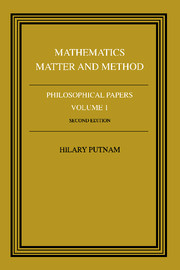Book contents
- Frontmatter
- Contents
- Dedication
- Introduction
- 1 Truth and necessity in mathematics
- 2 The thesis that mathematics is logic
- 3 Mathematics without foundations
- 4 What is mathematical truth?
- 5 Philosophy of physics
- 6 An examination of Grünbaum's philosophy of geometry
- 7 A philosopher looks at quantum mechanics
- 8 Discussion: comments on comments on comments: a reply to Margenau and Wigner
- 9 Three-valued logic
- 10 The logic of quantum mechanics
- 11 Time and physical geometry
- 12 Memo on ‘conventionalism’
- 13 What theories are not
- 14 Craig's theorem
- 15 It ain't necessarily so
- 16 The ‘corroboration’ of theories
- 17 ‘Degree of confirmation’ and inductive logic
- 18 Probability and confirmation
- 19 On properties
- 20 Philosophy of Logic
- Bibliography
- Index
- Frontmatter
- Contents
- Dedication
- Introduction
- 1 Truth and necessity in mathematics
- 2 The thesis that mathematics is logic
- 3 Mathematics without foundations
- 4 What is mathematical truth?
- 5 Philosophy of physics
- 6 An examination of Grünbaum's philosophy of geometry
- 7 A philosopher looks at quantum mechanics
- 8 Discussion: comments on comments on comments: a reply to Margenau and Wigner
- 9 Three-valued logic
- 10 The logic of quantum mechanics
- 11 Time and physical geometry
- 12 Memo on ‘conventionalism’
- 13 What theories are not
- 14 Craig's theorem
- 15 It ain't necessarily so
- 16 The ‘corroboration’ of theories
- 17 ‘Degree of confirmation’ and inductive logic
- 18 Probability and confirmation
- 19 On properties
- 20 Philosophy of Logic
- Bibliography
- Index
Summary
Let us make up a logic in which there are three truth-values, T, F, and M, instead of the two truth-values T and F. And, instead of the usual rules, let us adopt the following:
(a) If either component in a disjunction is true (T), the disjunction is true; if both components are false, the disjunction is false (F); and in all other cases (both components middle, or one component middle and one false) the disjunction is middle (M).
(b) If either component in a conjunction is false (F), the conjunction is false; if both components are true, the conjunction is true (T); and in all other cases (both components middle, or one component middle and one true) the conjunction is middle (M).
(c) A conditional with true antecedent has the same truth-value as its consequent; one with false consequent has the same truth-value as the denial of its antecedent; one with true consequent or false antecedent is true; and one with both components middle (M) is true.
(d) The denial of a true statement is false; of a false one true; of a middle one middle.
These rules are consistent with all the usual rules with respect to the values T and F. But someone who accepts three truth values, and who accepts a notion of tautology based on a system of truth-rules like that just outlined, will end up with a different stock of tautologies than someone who reckons with just two truth values.
- Type
- Chapter
- Information
- Mathematics, Matter and MethodPhilosophical Papers, pp. 166 - 173Publisher: Cambridge University PressPrint publication year: 1979
- 2
- Cited by



